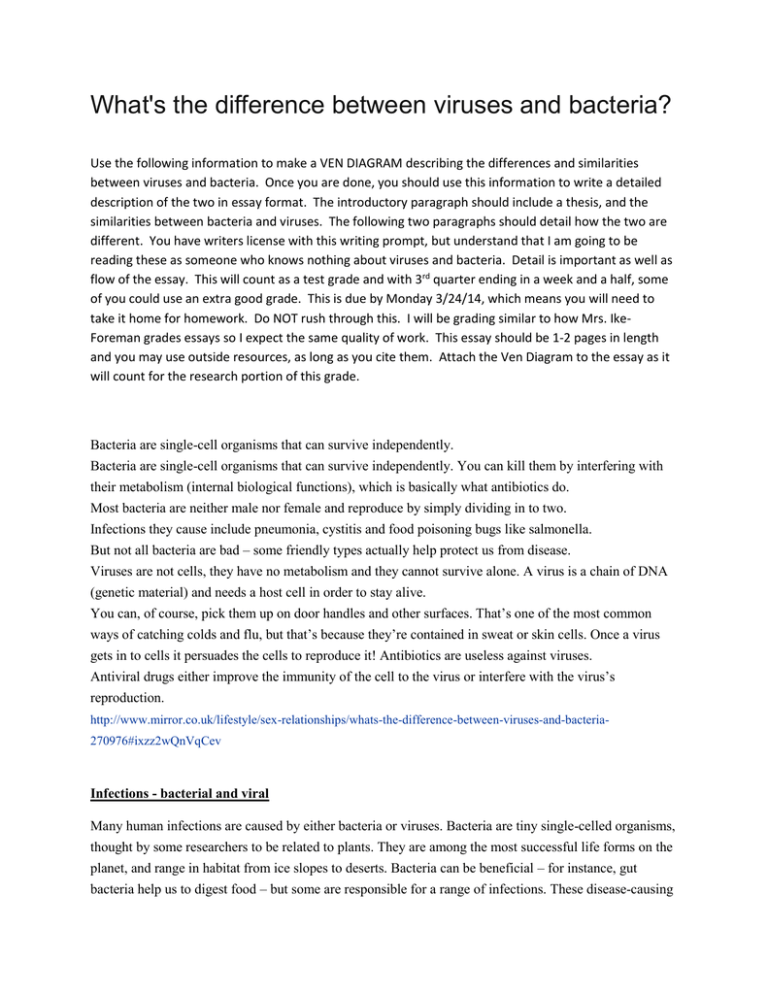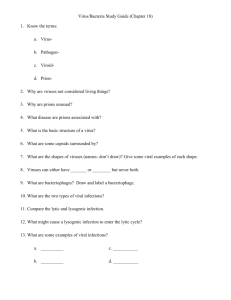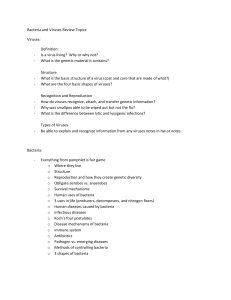Viruses vs. Bacteria: Venn Diagram & Essay Assignment
advertisement

What's the difference between viruses and bacteria? Use the following information to make a VEN DIAGRAM describing the differences and similarities between viruses and bacteria. Once you are done, you should use this information to write a detailed description of the two in essay format. The introductory paragraph should include a thesis, and the similarities between bacteria and viruses. The following two paragraphs should detail how the two are different. You have writers license with this writing prompt, but understand that I am going to be reading these as someone who knows nothing about viruses and bacteria. Detail is important as well as flow of the essay. This will count as a test grade and with 3rd quarter ending in a week and a half, some of you could use an extra good grade. This is due by Monday 3/24/14, which means you will need to take it home for homework. Do NOT rush through this. I will be grading similar to how Mrs. IkeForeman grades essays so I expect the same quality of work. This essay should be 1-2 pages in length and you may use outside resources, as long as you cite them. Attach the Ven Diagram to the essay as it will count for the research portion of this grade. Bacteria are single-cell organisms that can survive independently. Bacteria are single-cell organisms that can survive independently. You can kill them by interfering with their metabolism (internal biological functions), which is basically what antibiotics do. Most bacteria are neither male nor female and reproduce by simply dividing in to two. Infections they cause include pneumonia, cystitis and food poisoning bugs like salmonella. But not all bacteria are bad – some friendly types actually help protect us from disease. Viruses are not cells, they have no metabolism and they cannot survive alone. A virus is a chain of DNA (genetic material) and needs a host cell in order to stay alive. You can, of course, pick them up on door handles and other surfaces. That’s one of the most common ways of catching colds and flu, but that’s because they’re contained in sweat or skin cells. Once a virus gets in to cells it persuades the cells to reproduce it! Antibiotics are useless against viruses. Antiviral drugs either improve the immunity of the cell to the virus or interfere with the virus’s reproduction. http://www.mirror.co.uk/lifestyle/sex-relationships/whats-the-difference-between-viruses-and-bacteria270976#ixzz2wQnVqCev Infections - bacterial and viral Many human infections are caused by either bacteria or viruses. Bacteria are tiny single-celled organisms, thought by some researchers to be related to plants. They are among the most successful life forms on the planet, and range in habitat from ice slopes to deserts. Bacteria can be beneficial – for instance, gut bacteria help us to digest food – but some are responsible for a range of infections. These disease-causing varieties are called pathogenic bacteria. Many bacterial infections can be treated successfully with appropriate antibiotics, although antibiotic-resistant strains are beginning to emerge. Immunization is available to prevent many important bacterial diseases. A virus is an even smaller micro-organism that can only reproduce inside a host’s living cell. It is very difficult to kill a virus. That’s why some of the most serious communicable diseases known to medical science are viral in origin. How bacteria and viruses enter the body To cause disease, pathogenic bacteria must gain access into the body. The range of access routes for bacteria includes: Cuts Contaminated food or water Close contact with an infected person Contact with the feces of an infected person Breathing in the exhaled droplets when an infected person coughs or sneezes Indirectly, by touching contaminated surfaces – such as taps, toilet handles, toys and nappies. Viruses are spread from one person to another by: Coughs Sneezes Vomits Bites from infected animals or insects Exposure to infected bodily fluids through activities such as sexual intercourse or sharing hypodermic needles Forgetting to wash your hands after handling pets and animals is another way for germs to be taken in by mouth. Bacteria types Bacteria that cause disease are broadly classified according to their shape. The four main groups include: Bacilli – shaped like a rod with a length of around 0.03mm. Illnesses such as typhoid and cystitis are caused by bacilli strains. Cocci – shaped like a sphere with a diameter of around 0.001mm. Depending on the sort, cocci bacteria group themselves in a range of ways, such as in pairs, long lines or tight clusters. Examples include Staphylococci (which cause a host of infections including boils) and Gonococci (which cause the sexually transmissible infection gonorrhoea). Spirochaetes – as the name suggests, these bacteria are shaped like tiny spirals. Spirochaetes bacteria are responsible for a range of diseases, including the sexuallytransmissible infection syphilis. Vibrio – shaped like a comma. The tropical disease cholera, characterised by severe diarrhoea and dehydration, is caused by the vibrio bacteria. Characteristics of the bacterium Most bacteria, apart from the cocci variety, move around with the aid of small lashing tails (flagella) or by whipping their bodies from side to side. Under the right conditions, a bacterium reproduces by dividing in two. Each ‘daughter’ cell then divides in two and so on, so that a single bacterium can bloom into a population of some 500,000 or more within just eight hours. If the environmental conditions don’t suit the bacteria, some varieties morph into a dormant state. They develop a tough outer coating and await the appropriate change of conditions. These hibernating bacteria are called spores. Spores are harder to kill than active bacteria because of their outer coating. Curing a bacterial infection The body reacts to disease-causing bacteria by increasing local blood flow (inflammation) and sending in cells from the immune system to attack and destroy the bacteria. Antibodies produced by the immune system attach to the bacteria and help in their destruction. They may also inactivate toxins produced by particular pathogens, for example tetanus and diphtheria. Virus types A virus is a miniscule pocket of protein that contains genetic material. If you placed a virus next to a bacterium, the virus would be dwarfed. For example, the polio virus is around 50 times smaller than a Streptococci bacterium, which itself is only 0.003mm long. Viruses can be described as either RNA or DNA viruses, according to which type of nucleic acid forms their core. The four main types of virus include: Icosahedral – the outer shell (capsid) is made from 20 flat sides, which gives a spherical shape. Most viruses are icosahedral. Helical – the capsid is shaped like a rod. Enveloped – the capsid is encased in a baggy membrane, which can change shape but often appears spherical. Complex – the genetic material is coated, but without a capsid. The body’s response to viral infection Viruses pose a considerable challenge to the body’s immune system because they hide inside cells. This makes it difficult for antibodies to reach them. Some special immune system cells, called T-lymphocytes, can recognise and kill cells containing viruses, since the surface of infected cells is changed when the virus begins to multiply. Many viruses, when released from infected cells, will be effectively knocked out by antibodies that have been produced in response to infection or previous immunisation. Curing a viral infection Antibiotics are useless against viral infections. This is because viruses are so simple that they use their host cells to perform their activities for them. Antiviral drugs work differently than antibiotics by interfering with the viral enzymes. Antiviral drugs are currently only effective against a few viral diseases, such as influenza, herpes, hepatitis B and C and HIV – but research is ongoing. A naturally occurring protein, called interferon (which the body produces to help fight viral infections), can now be produced in the laboratory and is used to treat hepatitis C infections. Immunization against viral infection is not always possible It is possible to vaccinate against many serious viral infections such as measles, mumps, hepatitis A and hepatitis B. An aggressive worldwide vaccination campaign, headed by the World Health Organization (WHO), managed to wipe out smallpox. However, some viruses – such as those that cause the common cold – are capable of mutating from one person to the next. This is how an infection with essentially the same virus can keep dodging the immune system. Vaccination for these kinds of viruses is difficult, because the viruses have already changed their format by the time vaccines are developed. Where to get help Your doctor Your pharmacist Things to remember Many human illnesses are caused by infection with either bacteria or viruses. Most bacterial diseases can be treated with antibiotics, although antibiotic-resistant strains are starting to emerge. Viruses pose a challenge to the body’s immune system because they hide inside cells. It is possible to be vaccinated against some of the major disease-causing viruses (such as measles and polio), as well as bacterial diseases such as Hemophilus influenza Type B (Hib), tetanus and whooping cough. Bacteria (singular: bacterium) are unicellular microorganisms. They are typically a few micrometers long and have many shapes including curved rods, spheres, rods, and spirals. A virus (from the Latin noun virus, meaning toxin or poison) is a submicroscopic particle (ranging in size from 20–300 nm) that can infect the cells of a biological organism. Ribosomes Bacteria Viruses Present Absent Living organism Opinions differ on whether viruses are a form of life or Living attributes organic structures that interact with living organisms. Number of cells Structures Unicellular; one cell No cells; not living DNA and RNA floating freely in cytoplasm. Has cell wall and cell DNA or RNA enclosed inside a coat of protein. membrane. Cell wall Peptidoglycan/Lipopolysacchar ide No cell wall.Protein coat present instead. Antibiotics Vaccines prevent the spread and antiviral medications help to slow Treatment reproduction but can not stop it completely. Enzymes Yes Yes, in some Nucleus No No Virulence Yes Yes Localized Systemic Some bacteria are beneficial (e.g. certain bacteria are Viruses are not beneficial. However, a particular virus may be able to destroy brain tumors (see references). Viruses can be Infection Benefits required in the gut) useful in genetic engineering. Fission- a form of asexual Reproduction reproduction Invades a host cell and takes over the cell causing it to make copies of the viral DNA/RNA. Destroys the host cell releasing new viruses. Size Larger (1000nm) Smaller (20 - 400nm) Viruses are the smallest and simplest life form known. They are 10 to 100 times smaller than bacteria. The biggest difference between viruses and bacteria is that viruses must have a living host - like a plant or animal - to multiply, while most bacteria can grow on non-living surfaces. Bacteria are intercellular organisms (i.e. they live in-between cells); whereas viruses are intracellular organisms (they infiltrate the host cell and live inside the cell). They change the host cell's genetic material from its normal function to producing the virus itself. There are some useful bacteria but all viruses are harmful. Antibiotics can kill bacteria but not viruses. An example of a disease caused by bacteria is strep throat and an example of an affliction caused by a virus is the flu. Differences in reproduction Bacteria carry all the "machinery" (cell organelles) needed for their growth and multiplication. Bacteria usually reproduce asexually. In case of sexual reproduction, certain plasmids genetic material can be passed between bacteria. On the other hand, viruses mainly carry information - for example, DNA or RNA, packaged in a protein and/or membranous coat. Viruses harness the host cell's machinery to reproduce. Their legs attach onto the surface of the cell, then the genetic material contained inside the head of the virus is injected into the cell. This genetic material can either use the cell's machinery to produce its own proteins and/or virus bits, or it can be integrated into the cell's DNA/RNA and then translated later. When enough "baby" viruses are produced the cell bursts, releasing the new viral particles. In a sense, viruses are not truly "living", but are essentially information (DNA or RNA) that float around until they encounter a suitable living host. Transmission electron microscope (TEM) image of a recreated 1918 influenza virus Living vs. Non-living Bacteria are living organisms but opinions vary on whether viruses are. A virus is an organic structures that interacts with living organisms. It does show characteristics of life such as having genes, evolving by natural selection and reproducing by creating multiple copies of themselves through self-assembly. But viruses don't have a cellular structure or their own metabolism; they need a host cell to reproduce. It should be noted that bacterial species such as rickettsia and chlamydia are considered living organisms despite the same limitation of not being able to reproduce without a host cell. See also: Virus - Life Properties (Wikipedia)







